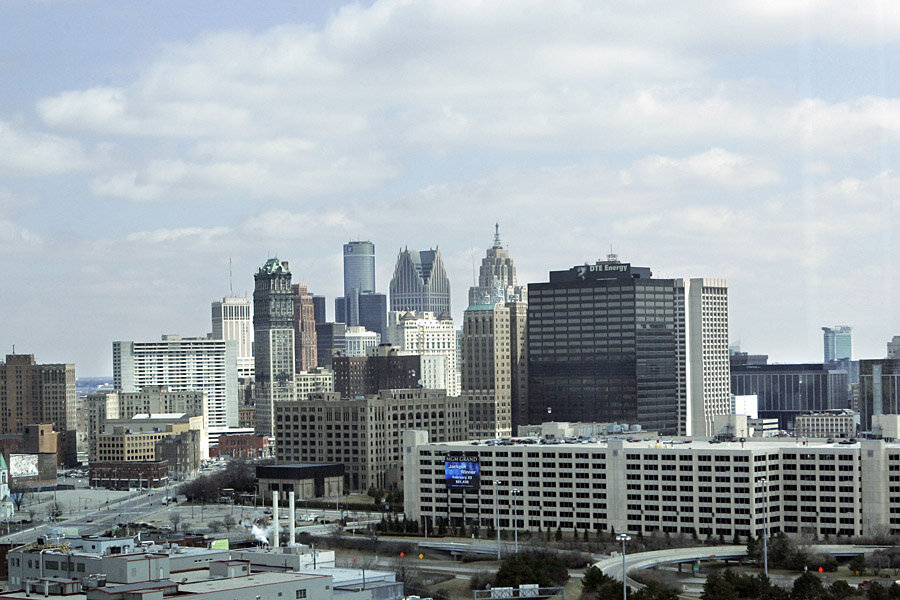Why the poor are paying for Detroit's bankruptcy
Loading...
Detroit is the largest city ever to seek bankruptcy protection, so its bankruptcy is seen as a potential model for other American cities now teetering on the edge.
But Detroit is really a model for how wealthier and whiter Americans escape the costs of public goods they’d otherwise share with poorer and darker Americans.
Judge Steven W. Rhodes of the U.S. Bankruptcy Court for the Eastern District of Michigan is now weighing Detroit’s plan to shed $7 billion of its debts and restore some $1.5 billion of city services by requiring various groups of creditors to make sacrifices.
Among those being asked to sacrifice are Detroit’s former city employees, now dependent on pensions and healthcare benefits the city years before agreed to pay. Also investors who bought $1.4 billion worth of bonds the city issued in 2005.
Both groups claim the plan unfairly burdens them. Under it, the 2005 investors emerge with little or nothing, and Detroit’s retirees have their pensions cut 4.5 percent, lose some health benefits, and do without cost-of-living increases.
No one knows whether Judge Rhodes will accept or reject the plan. But one thing is for certain. A very large and prosperous group close by won’t sacrifice a cent: They’re the mostly-white citizens of neighboring Oakland County.
Oakland County is the fourth wealthiest county in the United States, of counties with a million or more residents.
In fact, Greater Detroit, including its suburbs, ranks among the top financial centers, top four centers of high technology employment, and second largest source of engineering and architectural talent in America.
The median household in the County earned over $65,000 last year. The median household in Birmingham, Michigan, just across Detroit’s border, earned more than $94,000. In nearby Bloomfield Hills, still within the Detroit metropolitan area, the median was close to $105,000.
Detroit’s upscale suburbs also have excellent schools, rapid-response security, and resplendent parks.
Forty years ago, Detroit had a mixture of wealthy, middle class, and poor. But then its middle class and white residents began fleeing to the suburbs. Between 2000 and 2010, the city lost a quarter of its population.
By the time it declared bankruptcy, Detroit was almost entirely poor. Its median household income was $26,000. More than half of its children were impoverished.
That left it with depressed property values, abandoned neighborhoods, empty buildings, and dilapidated schools. Forty percent of its streetlights don’t work. More than half its parks closed within the last five years.
Earlier this year, monthly water bills in Detroit were running 50 percent higher than the national average, and officials began shutting off the water to 150,000 households who couldn’t pay the bills.
Official boundaries are often hard to see. If you head north on Woodward Avenue, away from downtown Detroit, you wouldn’t know exactly when you left the city and crossed over into Oakland County — except for a small sign that tells you.
But boundaries can make all the difference. Had the official boundary been drawn differently to encompass both Oakland County and Detroit – creating, say, a “Greater Detroit” – Oakland’s more affluent citizens would have some responsibility to address Detroit’s problems, and Detroit would likely have enough money to pay all its bills and provide its residents with adequate public services.
But because Detroit’s boundary surrounds only the poor inner city, those inside it have to deal with their compounded problems themselves. The whiter and more affluent suburbs (and the banks that serve them) are off the hook.
Any hint they should take some responsibility has invited righteous indignation. “Now, all of a sudden, they’re having problems and they want to give part of the responsibility to the suburbs?” scoffs L. Brooks Paterson, the Oakland County executive. “They’re not gonna’ talk me into being the good guy. ‘Pick up your share?’ Ha ha.”
Buried within the bankruptcy of Detroit is a fundamental political and moral question: Who are “we,” and what are our obligations to one another?
Are Detroit, its public employees, poor residents, and bondholders the only ones who should sacrifice when “Detroit” can’t pay its bills? Or does the relevant sphere of responsibility include Detroit’s affluent suburbs — to which many of the city’s wealthier resident fled as the city declined, along with the banks that serve them?
Judge Rhodes won’t address these questions. But as Americans continue to segregate by income into places becoming either wealthier or poorer, the rest of us will have to answer questions like these, eventually.






